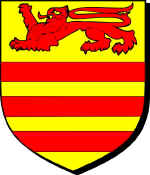
Heraldry
The Ormerod coat of arms was granted in the Visitation of Somerset in 1623 to Oliver Ormerod, M.A., rector of Huntspill in Somerset at that time.
The arms were granted to him "as the ancient coat of armour of his family", which indicates that Oliver claimed that the Ormerod Family had used this coat of arms since a time before the College of Heralds was established around 1484.
 |
The Ormerod Coat of Arms - Or, three bars and a lion passant in chief gules. |
The pedigree submitted by Oliver Ormerod in support of his claim to the Ormerod coat of arms does not stand up to scrutiny, and it would appear that Oliver was one of The Ormerods of Littlehouse in Gambleside, and not of the main branch of Ormerods of Ormerod.
The Ormerods of Ormerod made no attempt to register their arms in the visitation of Lancashire in the early seventeenth century, and according to Milton Ormerod, in The Ormerods, they never seem to have been used by them until shortly before T.D. Whitaker published his History of the Parish of Whalley at the beginning of the nineteenth century.
Milton Ormerod describes how they were "quoted in that history and their arms appeared with those of other local families in the great east window of Whalley parish church - although by that time the Ormerods of Ormerod had failed in the male line - and John Hargreaves who had married Charlotte Anne, the sole heiress to that line exhibited them as an escutcheon of pretence in the same window."
The fact that the Ormerods of Ormerod make no earlier claim to the coat of arms, does not, according to Milton Ormerod, mean that they never existed.
"The Ormerods had held land direct from the king at Ormerod since the 1320's at a nominal rent. Such arrangements were made by the crown in return for services. The only kind of service needed in that part of the world was armed service against the ever present threat of the incursions of the Scots who had advanced as far as Clitheroe and burnt it in 1197 and as far as Chorley in 1322. Armed service would have entitled the Ormerods to a coat of arms."
The Ormerods of Ormerod died out in the senior line in 1793, and their arms first appear on the memorial to the last of them in Holme church, and soon after they were quoted in Whitaker's History of Whalley.
They later appeared in the 1870s in Tunstead Parish Church, on the memorial tablet to the memory of George Ormerod of Fernhill, one of the Ormerods of Shawclough, Edgeside and Greensnook.
His son, George Henry Ormerod, of Edgeside Hall, impaled these arms there, with a crescent as a mark of cadency, with those of his wife - who was one of the eleven daughters of the last of the Turner family of Helmshore.